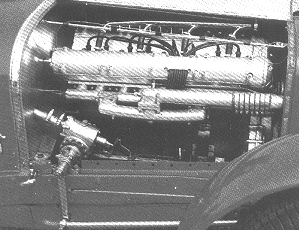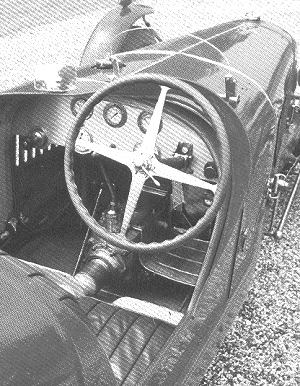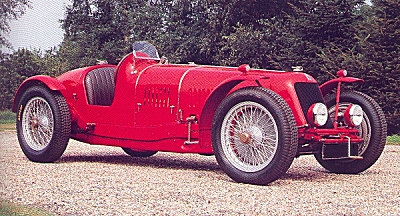| A Maserati Masterpiece The story of Tipo 8C-3000 - No 3002 |
| The Tipo 8C-3000 Maserati will go down in history as the last car Tim Birkin ever raced. Cyril Posthumus recalls the history of the car which recently emerged after an extensive rebuild by Cameron Millar. |
|
I would like to thank the David Prasher of 'Classic and Sportscar' magazine for his kind permission to reproduce the contents of this excellent article, that appeared in the October 1982 issue of 'Classic and Sportscar', for our enjoyment. |
The early years in the racing career of Cameron Millar's Maserati,
chassis and engine number 3002, were highly dramatic, as befits so delectable a piece of classic Italian machinery. Second of the 3-litre Tipo 8C-3000 series to be built and laid down
in 1932, it was the first to be supplied to a private owner, Bernard Rubin, a very rich Australian who bought the car from Officine Alfieri Maserati of Bologna for Henry R.S. 'Tim'
Birkin to drive. Both were former 'Bentley Boys', and both shared a Le Mans victory with Woolf Barnato: Rubin in 1928 and Birkin in 1929.
Tim Birkin was a great patriot, but the withdrawal from racing by Bentley Motors after their fifth Le Mans victory in 1930 left him little option
but to 'go foreign' for 1931. Accordingly he acquired a 2.3-litre straight-eight Alfa Romeo for the sports car events, and a Tipo 26M-2500 Maserati for Grand Prix - the latter a model
vitally important to the pedigree of Birkin's second Maserati.
Made in a tiny factory
The earlier 2½-litre burst upon the Continental Grand Prix scene in 1930, when Achille Varzi took the Pescara, Monza and Spanish GPs, Fagioli
took then Leghorn and Avellino races, and Arcangeli won the GP of Rome, all with the sleek new cars built at the factory at Pontevecchio, in Bologna, with a staff of about 25. Alfieri,
the eldest of the famous Fratelli Maserati who ran it, often referred deprecatingly to the works as 'these four floor tiles', but the cars that emerged made history for many years to come.
The 2½-litre Maserati's design format broadly followed the classic twenties pattern set by Fiat and Alfas Romeo. It had 65x94mm, 2495cc Roots-supercharged straight-eight
twin overhead camshaft engine, four-speed gearbox, torque tube final drive, and a channel-section chassis with semi-elliptic leaf springs and friction dampers all round. Structurally, however,
it was more advanced than the old P2 Alfas and Type 35 Bugattis it had thrashed during that epic 1930 season. Its five-bearing crankshaft had a central roller race, with one ball and one plain
bearing each side of it, while major parts of the engine, transmission, rear axle and brakes embodied that tough but new light alloy, elektron. Many of the components were forged or cast and
then machined for Maserati by the famous car and aero-engine makiers, Isotta-Fraschini of Milan, while a double drop frame made for low build and stability. The car was exceptionally attractive
with its sloping radiator and purposeful lines.
However, those anticipated 1930 successes goaded both Bugatti and Alfa Romeo into producing new and faster cars themselves for 1931, and the Officine Maserati found themselves dethroned.
The little Bologna factory's only quick answer was to enlarge the engine. The 65mm bore was opened out to 69mm, giving 2812cc and a claimed power increase from 175 to 205bhp at 5500rpm. The 1930-type
chassis was retained, but bodywork was lowered and cleaned up, and between its bebut in the 1931 French GP and its first and only major victory in the Monza GP that same year, the 2800 Maserati was
notable for its prodigious acceleration but shaky stamina. Its engine was clearly a transitional unit leading to the full 8C-3000 3-litre which appeared early in 1933. This measured 69 x 100mm (2992cc),
and while its specification broadly followed 1930 pattern, carburation and supercharging subtleties effected by the Weber company resulted in 210bhp at 5600rpm with improved performance throughout the range.
A scandalous race
The Birkin 8C-3000 was completed in time for the Tripoli GP in May, 1933, where it appeared alongside equally new works cars for Campari and Fagioli. As a private entry, there is
some doubt as to whether Birkin's car began life with a full 3-litre engine. The Motor in its race report said yes, The Autocar was non-committal, while the RAC d'Italia's own report listed it as a
2800, which suggests that Maserati put the only existing 3-litre engines into their works cars, with an interim 2.8 for the privateer, pending completion of his full '3000'.
That Tripoli race was, of course, notorious for what was called 'the great lottery scandal', but less known for the truly remarkable drive by Tim Birkin. The lottery, a kind of motor racing 'Irish sweep',
was the AC of Tripoli's ingenious method of helping to pay for their permanent circuit, laid out in the desert behind the famous North African port. A National lottery with huge cash prizes was promoted, ticket buyers who
drew any of the 30 drivers competing getting an 8-day expenses-paid trip to the race. Three lucky ones who drew Varzi, Nuvolari and Borzacchini got together with these drivers and jointly 'fixed it' to share all potential winnings.
After a dramatic race Varzi in his 2.3-litre twin-cam Bugatti won at 104.76mph by just 0.2sec from Nuvolari's 2.6 Alfa Romeo, the victor allegedly collecting a cool £15,000 and his partners some impressive sums
too, all of which set up cries of whatever in Italian stands for 'fiddle'! All this apart, however, other interest centred on the third man home, none other than Sir Henry (Tim) Birkin in his new Maserati. In a strange car on a
strange circuit, against the craftiest of Continental professionals, he put up a fantastic fight - and that despite a works mix-up which left him without a mechanic, the one man sent from Pontevecchio naturally looking after the
factory 3-litres.
Victory lost in a pit-stop
Yet Birkin took the lead on lap I and held it for four rounds when the burly Campari went past. Nuvolari next came by but Birkin found that with his Maserati's 142 mph maximum he could hold the
Alfa comfortably. Then came the pit stops and Birkin, who had recruited a somewhat raw local garage hand as helper, lost his chance of victory in a 2¾ minutes stop during which Varzi and Nuvolari pulled inexorably ahead,
while Campari retired. Then one of Birkin's tyres went bald, but with no pits facilities he decided to nurse it home, finishing the 393kms race just over 1½ minutes behind the warring leaders.
Who could know that, behind the euphoria of that brilliant Tripolin third, lurked tragedy. During practice birkin dropped his cigarette lighter in the cockpit, and in reaching for it he burned his arm on the
hot exhaust pipe. A malaria sufferer since the Great War,he was already in a poor state of health and that burn, allied with mosquito bites, put him into hospital with septicaemia six days later. Five weeks after that,
shatteringly, Tim Birkin was dead, and Britain lost one of the finest and most colourful drivers.
Maserati 3002 was raced no more that year, but in 1934 it was purchased by Noel Rees, a prosperous building contractor, for the Hon. Brian Lewis to drive, He ran it at the International Trophy at Brooklands,
coming up against Whitney Straight in the newest 2.9-litre single-seater Maserati equipped with a Wilson preselector gearbox. After an epic struggle, Lewis came within a whisker of victory, for Straight won from the older car by
just 4secs, with one of his tyres right down to the white breaker strip. One more lap and 3002 could well have won, but at least she shared the fastest lap with her more modern rival at 55.13mph. In the British Empire Trophy at
the same track the car misbehaved, a broken connecting rod putting Lewis out when holding third place on lap 63. In 1935 another Tim, stockbroker T.E. Rose-Richard, acquired the car, but his tenure was brief and his ride even
briefer, his only race with 3002 being the Mannin Moar at Douglas, Isle of Man, where he covered less than a lap before the universal joint broke.
By then so overwhelming was design progress with the comimg of the German teams, that the car which led the Tripoli GP two seasons ago was now 'second division', contesting secondary races only. Lord 'Freddy'
de Clifford drove it in the Dieppe GP to a steady ninth place amidst a welter if single-seaters. Next, Austin Dobson, elder brother of Arthur and a man who liked GP cars, bought the 'Maser'. In the 1935 Pheonix Park race he came
within 0.4mph of setting the first 100mph lap at the Dublin circuit, but a broken oil pump was his sole reward. In the 1936 International Trophy he again retired, and it was all too obvious that the new generation ERAs with half
the engine capacity were faster than the great old car.
But another Dobson brother, E.W.H., drove 3002 twice at Brooklands in 1937, picking up a third place in a Mountain event, after which the Birkin Maserati entered a long spell of retirement. She languished
unexercised for long months at Thompson & Taylors down at Brooklands, while during the War R.F. Oats took her to safety in Cornwall. Not until the return of peace did the grand old lady return to the circuits, but not, alas,
to Brooklands, which was a lamented war casualty. Yet it was the former Brooklands driver, Dudley Froy, who gave 3002 her first stretch in nine years at the VSCC's Elstree speed trials at Easter, 1946. Incorrectly he was
awarded first place in the over 3-litre class until it was realised that 2992cc put him in the 2 to 3-litre category and demoted him to third place.
At that time the car was in the hands of John Wyer, then of Ace Motors and subsequently of Le Mans fame, but shortly afterwards a long-term admirer of the Maserati, T.A.S.O. Mathieson, acquired the car
and had it prepared by Wyer for some Continental racing. In the anarchy of early post-war 'Grand Prix' racing, a 14-year-old supercharged Maserati was no more anachronistic than superannuated voiturettes and stripped
sports models, and 3002 had a new lease of life. As the very first Briton to race abroad, 'Taso' was warmly welcomed at the Bois du Boulogne race in May 1946, where he worked the 'Maser' up to fourth position, only to
drop out after 22 laps. In the GP of St Cloud he came fifth behind three modern 1½-litre Maseratis and a 4½-litre single-seater Talbot. At Perpignan in a very hot GP du Rousillon down in the Pyrenees, he was sixth
despite several pit stops, preceded by a 3-litre GP Alfa, two 1.5-litre Maseratis and a contemporary Bugatti. |
Conversion to road trim |
|
Cylinder block troubles prevented Mathieson from starting in the Nantes GP, and that concluded his season. 3002 now underwent a somewhat protracted conversion to road trim by the addition
of lights, battery and dynamo, a starter motor, a silencer to muffle that lovely eight-cylinder blast, four shapely cycle wings, a second seat where once a 10 gallon oil tank lived next to the driver, and registration plates
indicating that 3002 was now also *** ***, able to legally run on the King's highway.
In 1947 'Taso' sold the car, still unfinished, to Mike Oliver of Continental Cars (and later Connaught) of Send, Surrey. Oliver exercised it in the Luton Hoo sprints early in 1948, scoring a modest seventh
in class, and not not long after was persuaded to sell it to Squadron Leader John Crampton, DFC, who had fallen for 3002 at first sight. He drove her in a few more 1948 'shorties' such as Prescott and Shelsey, and at Brighton
and Goodwood in 1949, after which a complete rebuild at the renowned Phoenix Green Garage at Hartley Wintney was undertaken by Alan Southon. This perforce included the fitting of a removable steering wheel, Crampton being
well over 6ft tall.
The rebuild was both extensive and expensive, but what a glorious road car resulted - 120 mph or more, over-80 mph cruising, 12 to 15mpg, prodigious acceleration with circa 200bhp underfoot, equally prodigious
deceleration with four 15 inch diameter cable-operated brakes, all the cachet of a real Grand Prix car, and such looks 'as dreams are made on'. . .
A longish sojourn in the 'States followed, but eventually that incurable Maserati addict, Cameron Millar, found 3002 and brought her back to Britain for yet another rebuild, to the intoxicating condition in
which she is shown here. |
 |
 |
|
 |
 |
||
|
To enter Enrico's Maserati Pages CLICK HERE! Copyright: Enrico's Maserati Pages - © 2000-2004. All rights reserved. |